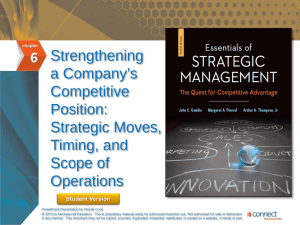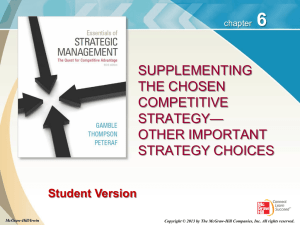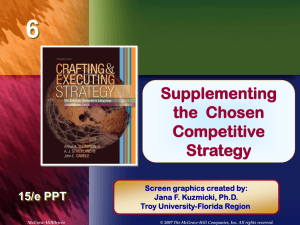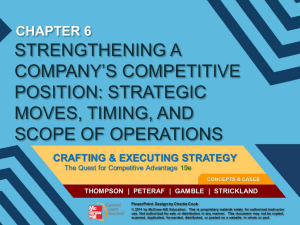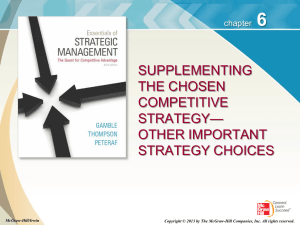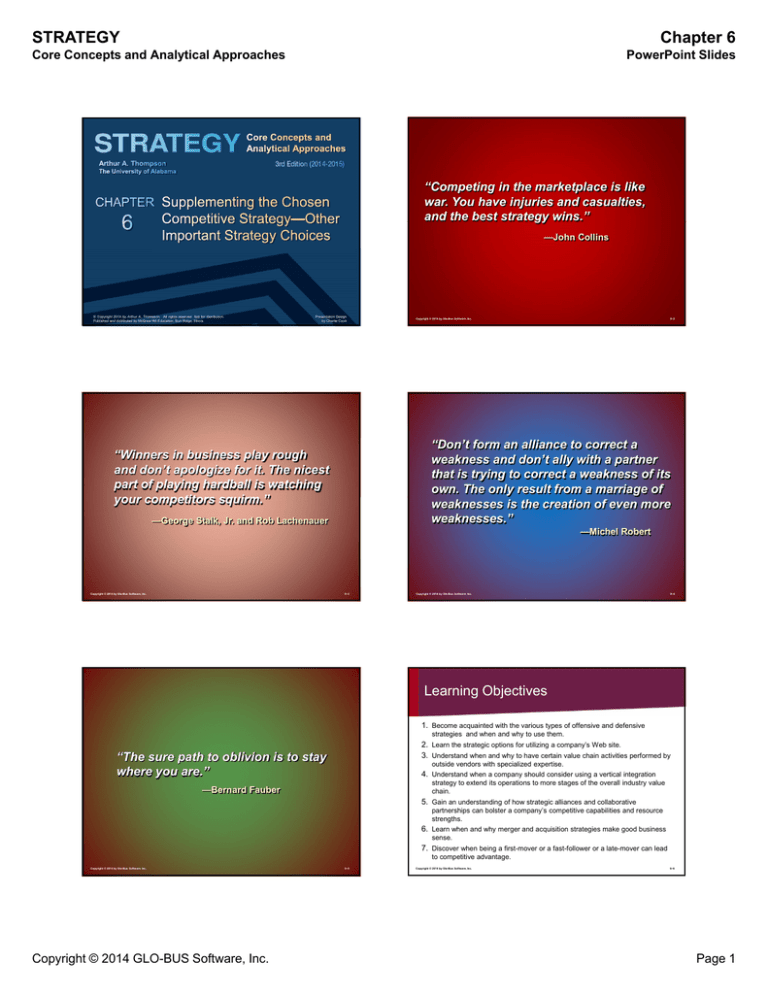
STRATEGY
Chapter 6
Core Concepts and Analytical Approaches
PowerPoint Slides
“Competing in the marketplace is like
war. You have injuries and casualties,
and the best strategy wins.”
—John Collins
© Copyright 2014 by Arthur A. Thompson. All rights reserved. Not for distribution.
Published and distributed by McGraw Hill Education, Burr Ridge, Illinois
Copyright © 2014 by Glo-Bus Software, Inc.
Presentation Design
~–1
by Charlie Cook
Copyright © 2014 by Glo-Bus Software, Inc.
0–2
“Don’t form an alliance to correct a
weakness and don’t ally with a partner
that is trying to correct a weakness of its
own. The only result from a marriage of
weaknesses is the creation of even more
weaknesses.”
“Winners in business play rough
and don’t apologize for it. The nicest
part of playing hardball is watching
your competitors squirm.”
—George Stalk, Jr. and Rob Lachenauer
—Michel Robert
Copyright © 2014 by Glo-Bus Software, Inc.
0–3
Copyright © 2014 by Glo-Bus Software, Inc.
0–4
Learning Objectives
1. Become acquainted with the various types of offensive and defensive
strategies and when and why to use them.
2. Learn the strategic options for utilizing a company’s Web site.
3. Understand when and why to have certain value chain activities performed by
“The sure path to oblivion is to stay
where you are.”
outside vendors with specialized expertise.
4. Understand when a company should consider using a vertical integration
strategy to extend its operations to more stages of the overall industry value
chain.
—Bernard Fauber
5. Gain an understanding of how strategic alliances and collaborative
partnerships can bolster a company’s competitive capabilities and resource
strengths.
6. Learn when and why merger and acquisition strategies make good business
sense.
7. Discover when being a first-mover or a fast-follower or a late-mover can lead
to competitive advantage.
Copyright © 2014 by Glo-Bus Software, Inc.
Copyright © 2014 GLO-BUS Software, Inc.
0–5
Copyright © 2014 by Glo-Bus Software, Inc.
6–6
Page 1
STRATEGY
Chapter 6
Core Concepts and Analytical Approaches
PowerPoint Slides
Supplementing a Company’s Competitive
Strategy: The Key Decisions
Chapter 6 Roadmap
A Company’s Menu of Strategic Choices
Going on the Offensive—Strategic Options to Improve a Company’s
Whether to go on the offensive and initiate aggressive strategic moves to
improve the company’s market position
Market Position
Whether to employ defensive strategies to protect the company’s market
Defensive Strategies—Protecting Market Position and Competitive
position
Advantage
What role the company’s Web site should play in its overall strategy to be a
Web Site Strategies
Outsourcing Strategies
Vertical Integration Strategies: Operating Across More Stages of
successful performer
Whether to outsource certain value chain activities or perform them in-house
Whether to integrate backward or forward into more stages of the industry
value chain
the Industry Value Chain
Strategic Alliances And Partnerships
Merger and Acquisition Strategies
Choosing Appropriate Functional-Area Strategies
Timing a Company’s Strategic Moves
Copyright © 2014 by Glo-Bus Software, Inc.
FIGURE 6.1
Whether to enter into strategic alliances or partnership arrangements with
other enterprises
Whether to bolster the firm’s market position via mergers or acquisitions
When to undertake strategic moves—whether advantage or disadvantage lies
in being a first-mover, a fast follower, or a late-mover
6–7
A Company’s Menu of Strategy Options
Copyright © 2014 by Glo-Bus Software, Inc.
6–8
Going On the Offensive—Strategic Options
to Improve a Company’s Market Position
Going on the offensive to improve a firm’s market
position and business performance is often necessary
when:
►
►
►
A firm has no choice but to try to whittle away at a strong rival’s
competitive advantage
It can reap the benefits a competitive edge offers—a leading
market share, excellent profit margins and rapid growth (as
compared to rivals)
It can gain the reputational rewards of being known as a firm on
the move
Strategy
Principle
Copyright © 2014 by Glo-Bus Software, Inc.
6–9
Successful offensive strategies are needed to build
competitive advantage, widen an existing advantage, or
narrow the advantage held by a strong competitor.
Copyright © 2014 by Glo-Bus Software, Inc.
6–10
Crafting a Potent Offensive Strategy:
Things to Do
Core Concept
Sometimes a firm’s best strategic option is to
seize the initiative, go on the attack, and launch a
strategic offensive to improve its market position.
It takes successful offensive strategies to build
competitive advantage, widen an existing
advantage, or narrow the advantage held by a
strong competitor.
Focus relentlessly on
►
Building competitive advantage and
►
Striving to convert it into decisive advantage
Employ the element of surprise; do the unexpected, rather
than what rivals may be prepared for
Apply competitive resources where rivals are least able to
defend themselves
Strategy
Principle
The best offensives use a firm’s resource strengths and
most potent competitive assets to attack rivals in areas
where they are competitively weak.
Copyright © 2014 by Glo-Bus Software, Inc.
Copyright © 2014 GLO-BUS Software, Inc.
Be impatient with the status quo—take swift and decisive
actions to try to overwhelm rivals
6–11
Copyright © 2014 by Glo-Bus Software, Inc.
6–12
Page 2
STRATEGY
Chapter 6
Core Concepts and Analytical Approaches
PowerPoint Slides
Deciding How to Attack Rival Companies
The Principal Offensive Strategy Options
Attack competitor weaknesses rather than challenging
Offer an equally good or better product at a lower price
Leapfrog competitors by being:
competitor strengths, especially if those weaknesses
represent important vulnerabilities and weaker rivals can
be caught by surprise with no ready defense
Base offensives on the company’s most potent
First to market with next-generation products
market share away from less innovative rivals
Its core competencies, competitive capabilities and valuable
resource strengths, such as a better-known brand name,
manufacturing or distribution cost advantages, superior
technological capability, or a better product
Adopt and improve on good ideas of other firms (rivals or
otherwise)
Failure to tie an offensive to competitive strengths and
what the firm does best dims the prospects for success.
Copyright © 2014 by Glo-Bus Software, Inc.
A first adopter of next-generation technologies
►
Pursue continuous product innovation to draw sales and
competitive assets
►
►
6–13
The Principal Offensive Strategy Options
(cont’d)
Deliberately attack a key rival in those market segments
where it makes big profits
Copyright © 2014 by Glo-Bus Software, Inc.
6–14
Choosing Which Rivals to Attack
Attack the competitive weaknesses of rivals
Maneuver around competitors to capture unoccupied or
Vulnerable market
leaders
less-contested market territory
Use hit-and-run or guerrilla warfare tactics to grab sales
Best Targets
for Offensive
Attacks
Struggling firms on
the verge of going
under
and market share from complacent or distracted rivals
Small local or regional
firms with limited
capabilities
Launch a preemptive strike to secure an advantageous
position that rivals are prevented or discouraged from
duplicating
Copyright © 2014 by Glo-Bus Software, Inc.
Runner-up firms with
weaknesses in areas where
the challenger is strong
6–15
Blue Ocean Strategy—A Special Kind
of Offensive
Typical Market Space
►
advantage by:
►
►
Abandoning efforts to defeat competitors in existing
markets and
►
Inventing a new industry or distinctive market
segment that renders existing competitors largely
irrelevant and
►
►
Allowing a company to create and capture altogether
new demand
Copyright © 2014 by Glo-Bus Software, Inc.
Copyright © 2014 GLO-BUS Software, Inc.
6–16
What Is Different About a Blue Ocean?
Seeks to gain a dramatic, durable competitive
►
Copyright © 2014 by Glo-Bus Software, Inc.
6–17
Industry boundaries are
defined and accepted
Competitive rules of the
game are well understood
and accepted by rivals
Companies try to outperform
rivals by capturing a bigger
share of existing demand
Lively competition
constrains a firm’s prospects
for rapid growth and
superior profitability
Copyright © 2014 by Glo-Bus Software, Inc.
Blue Ocean Market Space
►
Does not exist yet
►
Is untainted by competition
►
Offers wide-open opportunities
if a firm has a product and
strategy allowing it to:
• Create new demand
• Avoid fighting over existing
demand
6–18
Page 3
STRATEGY
Chapter 6
Core Concepts and Analytical Approaches
PowerPoint Slides
Defensive Strategies—Protecting Market
Position and Competitive Advantage
Objectives
Approaches
Lower the risk of being
attacked
► Weaken the impact of
any attack that occurs
► Influence challengers
to aim attacks at other
rivals
►
►
Good defensive strategies can help protect
competitive advantage but rarely are the basis
for creating it.
Block the avenues
open to challengers
► Signal challengers that
retaliation is likely
Copyright © 2014 by Glo-Bus Software, Inc.
6–19
Using Defensive Strategies to Block the
Avenues Attack Open to Challengers
Copyright © 2014 by Glo-Bus Software, Inc.
6–20
Signaling Challengers that Retaliation Is Likely
There are four ways to signal potential challengers of
Participate in alternative technologies
Introduce new features, add new models, or broaden the product line
probable retaliation if they launch an offensive attack to
grab a bigger market share:
to close gaps and niches rivals may pursue
Maintain economy-priced models and options
Lengthen warranties
Offer free training and support services
Reduce delivery times for spare parts
Provide coupons and free samples
Make early announcements about new
products or price changes
Challenge quality or safety of rivals’ products
Offer volume discounts, better financing terms,
and exclusive agreements with distributors
Copyright © 2014 by Glo-Bus Software, Inc.
Core Concept
6–21
►
Publicly announce management’s commitment to
maintain the firm’s present market share
►
Publicly commit the firm to a policy
of matching rivals’ prices or terms
►
Maintain a war chest (reserves)
of cash and marketable securities
►
Make occasional strong counterresponses to moves of weaker rivals
Competitors
Beware
!!!
Copyright © 2014 by Glo-Bus Software, Inc.
Web Site Strategies
Product Information-Only Strategies:
Avoiding Channel Conflict
Strategic Question:
At manufacturer’s web site, provide extensive product
►
6–22
information and links for network dealer and wholesaler
websites
What role should a firm’s Web site play in its strategy?
Strategic Approaches to Using the Web Site
Avoiding channel conflict when the support and goodwill of
► Only to disseminate product information
dealers is essential—an information-only site partners with
dealers rather than competes with them
► As secondary or minor distribution channel
to sell directly to customers
Avoid channel conflict by relying on dealer Web sites to
► As one of several distribution channels
to access customers
finalize sales and inform end-user consumers of retail
store location
► As the primary distribution channel for assessing customers
► As the company’s exclusive channel for transacting sales with
customers
Copyright © 2014 by Glo-Bus Software, Inc.
Copyright © 2014 GLO-BUS Software, Inc.
6–23
Copyright © 2014 by Glo-Bus Software, Inc.
6–24
Page 4
STRATEGY
Chapter 6
Core Concepts and Analytical Approaches
PowerPoint Slides
Web Site e-Stores as a Minor
Distribution Channel
Reasons to Use Web Site e-Store
as a Minor Distribution Channel
Approach–Use online sales to:
A strategy to gradually grow online sales into a direct
►
Achieve incremental sales
►
Gain online sales experience
►
Conduct marketing research
distribution channel makes sense when:
►
Profit margins from online sales are bigger than those earned
from selling to wholesale/retail customers
►
Encouraging buyers to visit a firm’s site educates them about the
ease and convenience of shopping online, increasing the
likelihood of more higher-margin online purchasing over time
►
Selling directly to end users allows a firm to make greater use of
build-to-order manufacturing and assembly and begin the
process of streamlining its value chain
• Learn more about buyer tastes and preferences
• Test reactions to new products
• Create added market buzz about products
Unlikely to provoke much outcry from dealers as
long as sales volume remains quite low
Copyright © 2014 by Glo-Bus Software, Inc.
6–25
Brick-and-Click Strategies:
An Appealing Middle Ground Approach
►
Approach: Use the Internet as the exclusive channel for all buyerseller contact and transactions
Selling to consumers at firm-owned retail store locations (brick)
Selling directly to consumers at the firm’s Web site (click)
Strategic issues for an online firm:
►
The strategic appeal of brick-and-click strategies for
►
wholesalers and retailers:
►
►
Sales at the firm’s Web site are a low-cost means of expanding its
geographic market reach
Customers have a choice of how to:
• Communicate with the firm
• Shop for product information
• Make and pick up purchases
• Resolve customer service problems
Copyright © 2014 by Glo-Bus Software, Inc.
►
►
►
6–27
How to deliver unique value to buyers
Whether to pursue competitive advantage based on lower costs,
differentiation, or better value for the money
Whether to have a broad or narrow product offering
Whether to perform order fulfillment activities internally or to
outsource them
How to draw traffic to its Web site and then convert page views
into revenues
Copyright © 2014 by Glo-Bus Software, Inc.
Outsourcing involves farming out the
performance of certain value chain activities to
outside vendors.
Outsourcing strategies involve a conscious decision to
not perform certain value chain activities internally and to
instead farm them out to outside specialists and strategic
allies.
Outsourcing
Internally Performed
Activities
Vendors with
specialized
expertise
Copyright © 2014 by Glo-Bus Software, Inc.
Copyright © 2014 GLO-BUS Software, Inc.
6–28
Core Concept
Outsourcing Strategies
Contract
manufacturers
6–26
Strategies for Online Enterprises
Two-Pronged Approach
►
Copyright © 2014 by Glo-Bus Software, Inc.
Strategy
Principle
While outsourcing can result in appealing benefits, a
company must guard against outsourcing activities that
hollow out the competitive capabilities and resource
strengths it needs to be a master of its own destiny.
Distributors or
retailers
6–29
Copyright © 2014 by Glo-Bus Software, Inc.
6–30
Page 5
STRATEGY
Chapter 6
Core Concepts and Analytical Approaches
PowerPoint Slides
The Big Risk of Outsourcing
Value Chain Activities
When Is Outsourcing Advantageous?
Outsourcing is appealing when a outsourcing a particular value chain
activity:
Results in the activity being performed better or more cheaply
Does not hinder or impair the firm’s ability to achieve a sustainable
competitive advantage
Reduces the firm’s risk exposure to changing technology or shifting
buyer preferences
Helps streamline operations, improves internal operating flexibility, or
reduces time-to-market for new products
Helps improve the firm’s ability to innovate
Facilitates assembling diverse kinds of expertise speedily and
efficiently
Allows the company to concentrate its energies on its core business,
better leverage its resource strengths, and do even better what it
already does best
Copyright © 2014 by Glo-Bus Software, Inc.
When a firm outsources too many or the wrong
activities, it risks
6–31
►
Hollowing out capabilities and being held hostage by
outside suppliers
►
Losing touch with activities and expertise that determine
overall long-term success
►
Undermining its ability to lead the development of
innovative new products (because cutting-edge ideas
and technologies for next-generation products now
come from outsiders)
Copyright © 2014 by Glo-Bus Software, Inc.
Vertical Integration Strategies: Operating
Across More Stages of the Value Chain
Integrating Backward to Achieve
Greater Competitiveness
Vertical integration extends a firm’s competitive
Integrating backward successfully requires a firm to:
and operating scope within the same industry.
►
Backward into sources of inputs/supply
►
Forward toward end-users of the final product
1. Achieve the same scale economies as outside suppliers
2. Match or beat suppliers’ efficiencies with no drop-off in quality
Backward integration can lead to lower costs and/or
reduced competitive risk when:
A vertical integration strategy can entail either partial
►
or full integration across the industry value chain
►
Value Chain
Activities, costs,
and margins of
suppliers
Internally performed
activities, costs,
and margins
►
►
Activities, costs,
and margins of
forward channel
allies and
strategic partners
Copyright © 2014 by Glo-Bus Software, Inc.
6–33
Suppliers have outsized profit margins
The item supplied is a major cost component
The requisite technological skills are easily mastered or acquired
There is a competitive necessity to keep proprietary know-how inhouse
Copyright © 2014 by Glo-Bus Software, Inc.
The Potential Benefits of Integrating
Backward
The Potential Benefits of Integrating
Backward (cont’d)
Can produce a differentiation-based competitive
Can enable better mastery of key skills or strategy-critical
advantage when performing activities internally:
►
Yields a better quality product/service offering
►
Improves the caliber of its customer service
►
Enhances the performance of its final product
6–32
6–34
technologies formerly performed by outsiders
Can facilitate adding product features/attributes that
deliver greater customer value
Lessens a firm’s vulnerability to powerful suppliers
inclined to raise prices at every opportunity
Reduced risk of depending on suppliers for crucial raw
materials, parts, components, and/or support services
Can add to a firm’s differentiation capabilities by building
or strengthening its core competencies
Copyright © 2014 by Glo-Bus Software, Inc.
Copyright © 2014 GLO-BUS Software, Inc.
6–35
Copyright © 2014 by Glo-Bus Software, Inc.
6–36
Page 6
STRATEGY
Chapter 6
Core Concepts and Analytical Approaches
PowerPoint Slides
The Potential Benefits of Integrating
Forward
The Disadvantages of a
Vertical Integration Strategy
Increases a firm’s capital investment in its industry,
To gain better access to end users and build stronger brand
awareness
To reduce dependence on the marketing and sales efforts of
independent distributors/ retailers that stock multiple brands and often
steer customers to the brands on which they earn the highest profit
margins
increasing business risk if industry demand, growth and
profitability should decline
Locks a firm into relying on its own in-house activities
(which later may prove more costly than purchasing from
best-in-class suppliers or using the services of
independent distributors and retail dealers)
To offset the lack of a broad product line, a firm may sell directly to
end users
To bypass independent distributors/ retailers in favor of direct sales at
Can impair a firm’s flexibility to accommodate shifting
company-owned stores and/or the company’s Web site which may
►
►
►
buyer preferences or a product design that requires
parts and components not made in-house
Lower distribution costs
Produce a relative cost advantage over rivals
Enable lower selling prices to end users
Copyright © 2014 by Glo-Bus Software, Inc.
6–37
The Disadvantages of a Vertical
Integration Strategy (cont’d)
Whether integration is a plus or a minus depends on:
integrated value chain for a while longer rather than undertake an
immediate value chain overhaul that entails big asset write-downs
(even though the overhaul might have considerable merit due to new
technology or other important industry developments).
►
►
Poses many different kinds of barriers to achieving full
economies of scale and at the same time only producing the
needed volumes
Often requires new or different skills and business capabilities
that entail considerable time and expense to develop the needed
proficiency (with no guarantee of success!)
6–39
A strategic alliance is a formal agreement between
►
►
6–40
Why form alliances and partnership?
two or more separate firms in which there is:
►
Copyright © 2014 by Glo-Bus Software, Inc.
Alliances and Partnerships
Have Strategic Value
Strategic Alliances and Partnerships
►
Whether it enhances strategy-critical activities in ways that lower
cost, build expertise, protect proprietary know-how, or increase
differentiation
Whether it reduces investment costs, increases flexibility and
response times, and reduces administrative costs of coordinating
operations across more value chain activities
► Whether it will substantially enhance the firm’s competitiveness and
profitability
Pursuing a vertical integration strategy hinges on which
capabilities and value-chain activities need to be performed inhouse and which are performed better or cheaper by outsiders
The faster the pace of change in an industry’s value chain system,
the bigger the risk of a vertical integration strategy
►
6–38
Weighing the Pros and Cons
of Vertical Integration
Creates a vested interest for the firm to stick with its vertically
Copyright © 2014 by Glo-Bus Software, Inc.
Copyright © 2014 by Glo-Bus Software, Inc.
Firms join together to complement their strategic
initiatives and strengthen their competitiveness.
► Alliances and collaborative partnerships stop short of
formal merger or joint ownership ties between the
partners
►
Strategically relevant collaboration of some sort
Joint contribution of resources
Shared risk
Shared control
Mutual dependence
Collaborative relationships between partners may entail a
contractual agreement but commonly stop short of formal
ownership ties between the partners
The purpose of a strategic alliance or collaborative partnership
is to join forces to achieve mutually beneficial outcomes.
Copyright © 2014 by Glo-Bus Software, Inc.
Copyright © 2014 GLO-BUS Software, Inc.
6–41
Copyright © 2014 by Glo-Bus Software, Inc.
6–42
Page 7
STRATEGY
Chapter 6
Core Concepts and Analytical Approaches
PowerPoint Slides
When Does an Alliance Become
“Strategic”?
Core Concept
Strategic alliances are collaborative
arrangements where two or more companies join
forces to achieve mutually beneficial outcomes.
An alliance becomes “strategic” when it:
The best alliances are highly selective, focusing
on particular value chain activities and on
obtaining a specific competitive benefit. They tend
to enable a firm to build on its strengths and learn.
Copyright © 2014 by Glo-Bus Software, Inc.
6–43
►
Facilitates achievement of an important business objective such as
lowering costs or delivering more value to customers
►
Helps build, strengthen, or sustain resources, competencies, and
competitive capabilities
►
Remedies a key resource deficiency or competitive weakness
►
Speeds development of technologies and/or product innovations
►
Facilitates entry into new geographic markets or pursuit of
important market opportunities
►
Blocks or defends against a competitive threat or mitigates a
significant risk to a firm’s business
Copyright © 2014 by Glo-Bus Software, Inc.
Why and How Strategic Alliances
Are Advantageous
Why and How Strategic Alliances
Are Advantageous (continued)
Firms commonly enter into strategic alliances to:
A firm that is racing for global market
►
Expedite development of promising new technologies or products
►
Overcome deficits in their own expertise and capabilities
►
Bring together the personnel and expertise needed to create
desirable new skill sets and capabilities
►
Improve supply chain efficiency
►
Gain economies of scale in production and/or marketing
►
Acquire or improve market access through joint marketing
agreements
►
Open up learning opportunities that help partner firms better
leverage their own resource strengths
Copyright © 2014 by Glo-Bus Software, Inc.
6–44
leadership needs alliances to:
6–45
►
Get into critical country markets quickly and
accelerate the building of its global market presence
►
Gain inside knowledge about unfamiliar markets
and cultures through alliances with local partners
►
Access valuable skills and competencies that are
concentrated in particular geographic locations
Copyright © 2014 by Glo-Bus Software, Inc.
Why and How Strategic Alliances
Are Advantageous (concluded)
Why Many Alliances Are Short-Lived
or Break Apart
A firm that is staking out a strong position in an
Most alliances based on technology-sharing or providing
industry of the future needs alliances to:
Establish a stronger initial competitive position for
participating in the target industry
► Master new technologies, new expertise and
competencies faster than through internal efforts alone
► Open up broader opportunities in the target industry
by melding the firm’s own capabilities with the expertise
and resources of partners
►
6–46
market access turn out to be temporary because
►
The benefits of mutual learning have occurred
►
Both partners have developed to the point where they are ready to
go their own ways
Alliances are more likely to be long-lasting when:
1. They involve collaboration with suppliers or distribution allies
2. Each party’s contribution involves activities in different portions of
the industry value chain
3. Continued collaboration is in the mutual interest of the partners
Copyright © 2014 by Glo-Bus Software, Inc.
Copyright © 2014 GLO-BUS Software, Inc.
6–47
Copyright © 2014 by Glo-Bus Software, Inc.
6–48
Page 8
STRATEGY
Chapter 6
Core Concepts and Analytical Approaches
PowerPoint Slides
Why Many Alliances Fail
Merger and Acquisition Strategies
50-70% of alliances are unsuccessful because:
A merger is the combining of two or more firms into a
►
The objectives and priorities of allies conflict or diverge
►
Allies discover they are unable to work well together
►
Changing conditions render the alliance obsolete
►
More attractive technological paths have emerged
►
One or more allies find they are becoming increasing
strong market rivals with other allies
single entity, with the newly created firm often taking on a
new name.
An acquisition is a combination in which one firm, the
acquirer, purchases and absorbs the operations of
another, the acquired.
The difference between a merger and an acquisition
is in the details of ownership, management control, and
financial arrangements–the resources, competencies,
and competitive capabilities of the newly created
enterprise end up much the same.
Alliances can help a firm reduce a competitive
disadvantage but rarely help secure a durable
competitive edge over rivals
Copyright © 2014 by Glo-Bus Software, Inc.
6–49
Copyright © 2014 by Glo-Bus Software, Inc.
When Does a Merger or an Acquisition
Make Strategic Sense?
Merger and Acquisition Strategies:
The Typical Objectives
Mergers and acquisitions are best for situations in which
Merger/acquisition strategies typically aim at
alliances or partnerships do not go far enough in providing
access to needed resources and competitive capabilities.
Combining two firms, via merger or acquisition, is an
attractive means of achieving operating economies,
strengthening competencies and competitiveness in
important ways, and opening up new market opportunities.
Strategy
Principle
The main impetus for employing merger and acquisition
strategies is to fundamentally alter a firm’s trajectory
and improve its business outlook.
Copyright © 2014 by Glo-Bus Software, Inc.
6–50
achieving any of four objectives:
1. Creating a more cost-efficient operation out of the
combined firms
2. Expanding a firm’s geographic coverage
3. Extending the firm’s business into new product
categories
4. Gaining quick access to new technologies or other
resources and competitive capabilities
6–51
Copyright © 2014 by Glo-Bus Software, Inc.
6–52
Why Mergers and Acquisitions Often
Result in Disappointing Outcomes
Merger and Acquisition Strategies:
The Typical Objectives
The managers overseeing the integration of operations make mistakes
More cost-efficient
operation of the
combined firms
in melding the activities of the acquiring and acquired firms.
Cost savings prove smaller than expected while gains in competitive
capabilities take longer to realize, or never materialize at all.
Expansion of
geographic coverage
Objectives of
Merger and
Acquisition
Strategies
Efforts to mesh the corporate cultures stall out due to resistance from
organization members as differences in management styles and
operating procedures prove hard to resolve.
Extending into new
product categories
Key employees at the acquired firm become disenchanted with newly
instituted changes and leave.
Personnel at the acquired firm stonewall changes, arguing forcefully
Quick access to
new technologies or
other resources and
competitive capabilities
Copyright © 2014 by Glo-Bus Software, Inc.
Copyright © 2014 GLO-BUS Software, Inc.
for doing things the way they were done prior to the acquisition.
6–53
Copyright © 2014 by Glo-Bus Software, Inc.
6–54
Page 9
STRATEGY
Chapter 6
Core Concepts and Analytical Approaches
PowerPoint Slides
Choosing Appropriate
Functional-Area Strategies
Timing a Company’s Strategic Moves
Choosing involves making strategic choices about how
Timing is especially important when there are
various functional parts of the business (R&D,
production, marketing, finance, etc.) will be managed to
support competitive strategy and other strategic moves
►
►
The bigger the first-mover advantages, the more
The nature of functional strategies is dictated by the
attractive and competitively important it is to
be a first-mover or early mover
The bigger the first-mover disadvantages, the
more attractive it is to be a follower or late
mover
choice of competitive strategy and other business-level
strategy elements
►
Functional managers must tailor the firm’s functional-area
strategies to support higher-level strategies
Copyright © 2014 by Glo-Bus Software, Inc.
Significant first-mover advantages
Significant first-mover disadvantages
6–55
Copyright © 2014 by Glo-Bus Software, Inc.
6–56
Core Concept
When Being a First-Mover Pays Off
Because of first-mover advantages and disadvantages, competitive
advantage can spring from when a move is made as well as from
what move is made.
Being first to make a strategic move has appeal when:
Pioneering the market helps build the first mover’s image and reputation
Early commitments to new technologies, new-style components, new or
To sustain any advantage that initially accrues to a pioneer, a firstmover must be a fast learner and continue to move aggressively to
capitalize on any initial pioneering advantage. It helps immensely if the
first-mover has deep financial pockets, important competencies and
competitive capabilities, and astute managers.
emerging distribution channels, and so on produce an absolute cost
advantage over rivals
First-time customers face significant costs in later switching to the product
offerings of follower firms
Moving first constitutes a preemptive strike (like securing an especially
favorable location or acquiring an appealing company with uniquely valuable
resources or capabilities)
A first-mover’s advantages are fleeting if its skills, know-how, and
actions are easily copied or even surpassed; in such cases, followers
and even late-movers can catch or overtake the first-mover in a
relatively short period.
Actions are protected by patents, copyrights, or other forms of property
rights, thus thwarting a response by would-be followers
Actions prove so overwhelmingly popular that its product sets the technical
standards for the industry
Copyright © 2014 by Glo-Bus Software, Inc.
6–57
The Potential for Late-Mover Advantages
or First-Mover Disadvantages
Key Issue: Is the race to industry leadership a sprint or a marathon?
experience or learning-curve benefits accrue to the first mover,
thereby enabling a follower to end up with lower costs than the firstmover (because the follower escapes the added costs of pioneering).
►
First-movers and fast-followers tend to win sprints; followers and latemovers often win marathons
With sprints, being a first-mover is competitively important because
pioneering early introduction of a technology or product
When the products of an innovator are primitive and do not live up to
buyer expectations, thus allowing a clever follower with betterperforming products to win disenchanted buyers away from the leader.
When the demand side of the marketplace is skeptical about the
►
Delivers clear and substantial benefits to early adopters and buyers
►
Gives the pioneer a durable reputational head-start advantage because
early adopters/buyers remain loyal to the pioneer’s product offering
When the race is a marathon:
benefits of a new technology or product pioneered by a first-mover.
When rapid market evolution (due to fast-paced changes in either
technology or buyer needs and expectations) allows fast-followers and
cautious late-movers the opening to leapfrog a first-mover’s products
with more attractive next-version products.
Copyright © 2014 GLO-BUS Software, Inc.
6–58
To Be a First-Mover or Not
Moving first is more costly than imitating followership when few
Copyright © 2014 by Glo-Bus Software, Inc.
Copyright © 2014 by Glo-Bus Software, Inc.
6–59
►
The firms that end up dominating new-to-the-world markets are almost
never the pioneers that gave birth to brand-new markets
►
First-mover advantages are fleeting and there is time for resourceful fastfollowers and even late-movers to overtake the early leaders
Copyright © 2014 by Glo-Bus Software, Inc.
6–60
Page 10

